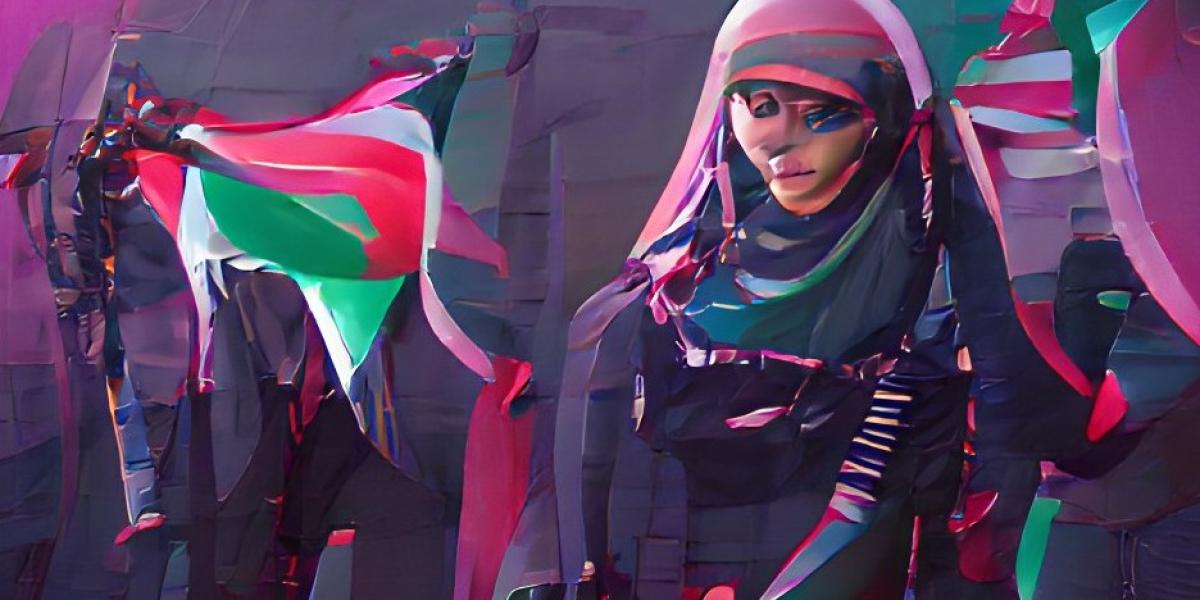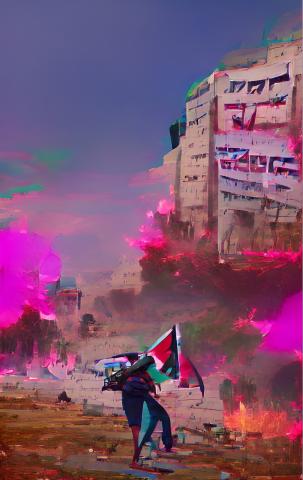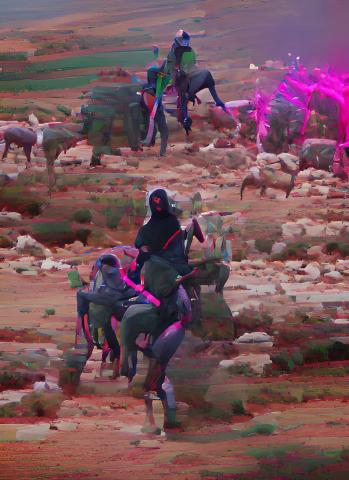Everybody has a car but my grandpa has a donkey
The song “everybody has a car but my grandpa has a donkey” – written by Elias Rahbani – is one of the songs that I grew up listening to and singing at school and home. Even before becoming familiar with the song, I was surrounded by animals like goats, sheep, chicken, and donkeys that were inherent to the Palestinian countryside. Rahabani’s sons performed the song nicely and we memorized the lyrics, which said: “while they all have cars, my grandpa won’t give up his donkey. He loves him so he gave him a blue bead to keep away the evil eye.”
The occupation, the donkey, and the black goat
Last July, on the Israeli channel 13, a news report called “the tough reality of donkeys in the country and the world” featured an Israeli farm owner explaining – with teary eyes – the abuse her donkeys were exposed to before they arrived at her farm, an oasis of peace. The animal-loving girl then declares that she will send 50 donkeys on a plane to the French countryside so they can enjoy a good life there. Her farm is flooded with donkeys, and she cannot save more. She said she wants them to live anywhere in the world “except in Gaza” as it is not a suitable place for donkeys.
The segment ends with a clear message about how caring and merciful Israelis are towards animals. However, the details about the hell that is Gaza have no place in the media as it does not match the image of the “civilized green humanity” that the occupation state and media are conveying to the world.
Gaza, which the occupation has turned into a big prison, is a place that is not suitable for humans or even donkeys. It is an overcrowded district besieged by the occupation that controls the details of its inhabitants’ lives, from quantities of food, medicine, and raw materials that are allowed into the strip, to hours of electricity, to the constant bombing of buildings and infrastructure and the human massacres.
The occupation uses the Gaza siege as a tool in their economic warfare to weaken Palestinian foundations. By separating the district from the West Bank, it has room to implement its apartheid plans. Gaza is one of the most densely populated areas in the world with a rate of 5500 persons per one meter square. However, “in France, each 4 donkeys will have 10 acres of land to wander and play in,” as the Israeli farm owner proudly said.
Under the occupation rule, colonizers impose restrictions on the natives to control their relationship with the surrounding environment and its animals and utilize it to disrupt their relationship with their land, control the economy, and limit their freedom of movement. In 1950, the Israeli occupation set a law that forbids Palestinians from herding goats in open spaces, only allowing one goat for every 40 acres of land. The law was set by the former prime minister David Ben Gurion, who called it the “law of plants’ protection/harms of goats,” later known as the “law of the black goat.”
Zionists claimed that black goats were eating the pinecones planted by the “Keren Kayemeth” (the Jewish National Fund), causing overgrazing and turning the land barren. In reality, this law further tightened the occupation’s grip on Palestinian farmers to reduce their produce and limit both theirs and their cattle’s movements. Even the forestation that Israel brags about was intended to erase the traces of hundreds of displaced Palestinian villages and obliterate its borders to prepare for the settlers coming to not only rob the people of their lands, but also to farm those lands and benefit from its goods.
The black goat does not understand settlers’ laws. It is a Palestinian pet on Palestinian land. It moves freely from one land to the other looking for food and water, and along moved Palestinian families. This agitated the occupation state and pushed it to launch campaigns in several areas, especially in the Negev, where goats herd in open spaces.
In 1976, the occupier state set up the “green patrols” led by Elon Ghalili, who has extensive experience in Bedouin displacement. The occupation army claimed that they were working to enforce the agricultural laws of open land. Bedouin women called them the “black patrols” because they mainly got rid of black goats, disrupted farmers’ work, and expropriated their houses and lands.
The 1950 law and its consequential procedures came under the slogan of fear of desertification and environmental imbalance, despite the fact that it only served the interests of the occupier, particularly the Israeli monopoly on agriculture and animal by-products. In doing so, the Nakba’s second generation witnessed the disappearance of several animal products that were an essential part of their diets. For instance, my mother was used to goat milk and cheese, so she could not easily accept the disappearance of these products from the market and their cow products replacement.
In 2010, the Carmel mountains’ fire killed 44 persons and destroyed thousands of trees. Only then was the black goat law repealed by the occupier state. They had learned, too late, that the elimination of black goats had hugely contributed to the spread of weeds and bushes among trees which led to fire outbreaks and conflagration.
Donkeys, just like Palestinian goats and their products, have also gradually and systematically disappeared from the lives of Palestinians, disrupting the lifestyle of the indigenous people and erasing the features of their environment.
The disappearance of donkeys and change of identity
In the old market of Nazareth, people, especially the elderly, suffer from the logistical difficulties of transporting goods to their homes because of the disappearance of donkeys from the market and the entire city. Donkeys were the main means of transportation in old Palestinian markets with narrow alleyways. However, the Zionist occupation wanted to radically change these markets and transform them into touristic areas, just like they did with old Palestinian towns such as Akka and Yafa, where Palestinian shops were turned into studios to showcase Israeli artists’ work and bazars for Israeli vendors to sell their merchandise to tourists. The occupation followed a detailed plan to eliminate donkeys and their owners from the old markets.
The disappearance of donkeys was noticeable in Palestinian villages and towns, especially the ones where Palestinian farmers still reside in. The researcher Razan Zoabi, who owns a studio in the old market of Al-Nasra, works to document the architectural heritage in the city. In her research, she links the disappearance of donkeys with the decline of the quality of life. In a conversation we had, Razan said: “My relatives have always mentioned donkeys as familiar animals of the city; each donkey has a known name in the market, like Mas’oud, Basem, or Yasmina, and the donkeys’ owners were known among the residents and shop owners as well.”
What happened to the donkeys after the occupation?
Razan tells me that the old town in Al-Nasra was “built according to the measures of donkeys, the only means of transportation back then.” In her work to preserve the memory of the place, Razan and her research team were aiming to document the disappearance of donkeys before turning their attention to the architecture. “We named this project ‘A disappearance story: a donkey, an alley, a story’ to document how donkeys disappeared from the public market.” The project was completed in cooperation with the Riwaq Riwaq Centre for Architectural Conservation to document the heritage and alleyways of Al-Nasra’s old market.
Donkeys disappeared from Al-Nasra in the 90s and early 2000s when the Israeli ministry of tourism decided to work on repairing the infrastructure of the city’s market through changing the entire transportation system. There were two types of donkeys in Al-Nasra: city council donkeys that were responsible for collecting the garbage, and house donkeys which were raised by families to help them in transportation and errands. In the 90s, the city council was moved from the district of Amaret Alsaraya to another area. Accordingly, donkey owners had to leave Alsaraya and evacuate the city council’s donkeys as well, which led to their scatter.
The occupation state set a touristic plan with a budget of 30 million shekels and appointed an Israeli architect to implement it. Razan says that this architect, who is known for building settlements, had his office built on the ruins of the displaced Palestinian village of Lifta. He worked on building the settlement of Kiryat Arba where he put his strong Zionist ideologies into practice. The Israeli touristic project radically changed Al-Nasra’s market: the thousand years old wooden doors of houses and shops were removed and replaced with metal gates. Each door had a different design that distinguished it, and it was replaced by homogenous colors. This was all done under the banner of “renovating the infrastructure” as officially announced.
“This is eradication and not renovation. The lives of many have been disrupted since you cannot transport your goods home. The elderly have left the market due to the difficulty of walking to and from it. All of this was clearly planned to transform the city to a touristic hub where only the Israeli style stands out and the Palestinian identity is completely erased,” said Razan. She further explains how she kept searching for a donkey to be part of a festive parade in Al-Nasra. Finding one was far from easy. After a long search, she managed to find two donkeys that Palestinian kids decorated with flowers; they walked alongside them to the old market until they reached the old “donkeys’ den.” The event was to challenge the Israeli unjust practices and laws. The old shop owners of Al-Nasra became very emotional at the sight of the donkeys walking in the market again – a sight they know is only temporary.
We do not know if today’s children will ever understand the extent to which the song “everybody has a car but my grandpa has a donkey” is meaningful to us.
Confiscating donkeys as an expansion strategy
Confiscating donkeys in the Negev area achieved certain strategic goals in the bigger colonial expansion plan of seizing more land in the region. In 2016, to further restrict the residents of the area, the Israeli state confiscated 40 donkeys from Bedouin farmers in the Jordan valley and publicly auctioned them. The occupation wanted to evacuate the valley to further exploit the area which has an abundance of natural resources and water. This was the third time in two years that the occupation confiscated donkeys and auctioned them under the banner of “protection of public safety.” The owners of confiscated donkeys are made to pay fines that are usually higher than the value of the donkey itself, so that the owner cannot eventually buy it back.
Another method adopted by the occupation to drive the residents out of the area of the Jordan riverbanks is to deprive them of water. The Israeli state forces Palestinians and Bedouins of this region to buy water at a hefty price while it extends channels and pipes on their lands to supply water to the surrounding settlements. The settlements get to enjoy water all year long while Bedouins’ cattle and produce perish among seasonal waves of drought and water scarcity. Negev residents continue to suffer under the Zionist settlement schemes; they are fighting a constant battle of existence, land, and survival against the project of “green settlement” that aims to eventually establish twelve new Zionist colonies and farms inside Bedouins’ residential areas.
Until this day, the occupation continues to confiscate donkeys in different areas. They often initiate donkey mass arrest campaigns under different allegations such as accusing a donkey rider of throwing stones on troops, or accusing the donkey itself of participating in riots, or even claiming that the donkey owner was not licensed to own it. The occupation fully controls the small details of Palestinians’ daily lives, even their animals’ lives. They impose laws and legalize procedures that would restrict any attempt of resistance.
Greenwashing from day one
It is not new for the occupation to cause damage to the Palestinian ecosystem in order to further expand settlements. Even before the occupation of Palestine, the White Paper issued by the British government in 1939 called for the establishment of a national Jewish state in Palestine, and by doing so, examined the ecological capacity of Jewish immigration. Immigration was decided according to this policy paper and the question of water in Palestine became political. The narrative of “water abundance” had greatly served the occupation ideologies; it was also used by the British and the Israelis to pass projects of water exploitation. For instance, they changed the narrative from water abundance to scarcity in the region in order to explain the reason behind the National Water Carrier project in 1964, which stole the waters of the Jordan River.
The Zionist occupation’s schemes of water had prompted the indigenous people to use armed resistance in order to defend their land and water resources. In 1964, the resistance in Eilabun village managed to destroy the Israeli water plant that was taking water away from Palestinian villages. The “operation of Eilabun” is considered one of the first operations that paved the way for the contemporary Palestinian revolution.
Several studies contain data, images, maps, and numbers that show the natural resources in Palestine before and after the occupation; they indicate how the expansion projects of settlements have destroyed large areas filled with natural resources. In her study titled “Israeli Management of Water Resources: a Story of Nation Building, Nature Transformation, and Alienation of Palestinians from their Environment” (2019), Lama Shehadeh mentions that before the occupation, natural reserves in Palestine spread over 28,000 hectares. However, the occupation reduced them to only 850 hectares under the supervision of the Jewish National Fund, Kakal. They have also dried 97% of marshlands.
The Israeli and western media use any opportunity to conceal the occupation’s colonial schemes that destroyed nature and Palestinians’ vital spaces. The Israeli news reports have lately been focusing on the green civilized image of the “ecological” occupation. TV channels regularly broadcast reports about veganism in Tel Aviv, and about the percentage of vegans in the city being one of the highest in the world. They boast that the occupation army wears boots made of recycled material and support such industries.
This image of shameless contradictions is apparent in ecological headlines that parallel those of the massacres of Palestinians and their resources, committed by the Israeli forces everyday on a daily basis. It is but another privilege utilized by the occupation to whitewash its image and conceal the reality behind its force of sheer destruction.



